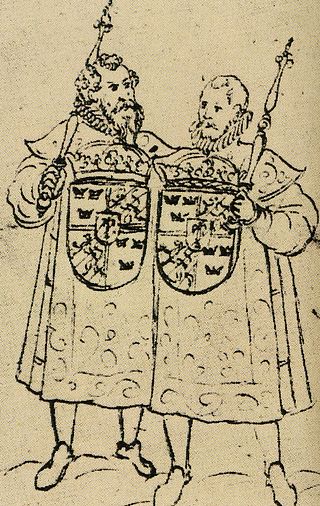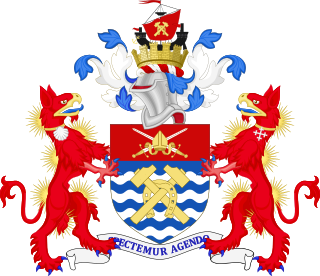
Heraldry is a discipline relating to the design, display and study of armorial bearings, as well as related disciplines, such as vexillology, together with the study of ceremony, rank and pedigree. Armory, the best-known branch of heraldry, concerns the design and transmission of the heraldic achievement. The achievement, or armorial bearings usually includes a coat of arms on a shield, helmet and crest, together with any accompanying devices, such as supporters, badges, heraldic banners and mottoes.
In heraldry, tenné is a "stain", or non-standard tincture, of orange, light brown or orange-tawny colour.

In heraldry, mantling or "lambrequin" is drapery tied to the helmet above the shield. In paper heraldry it is a depiction of the protective cloth covering worn by knights from their helmets to stave off the elements, and, secondarily, to decrease the effects of sword-blows against the helmet in battle, from which it is usually shown tattered or cut to shreds; less often it is shown as an intact drape, principally in those cases where clergy use a helmet and mantling, although this is usually the artist's discretion and done for decorative rather than symbolic reasons.

The coat of arms of Saskatchewan, officially known as His Majesty's Arms in right of Saskatchewan, is the heraldic symbol representing the Canadian province of Saskatchewan.

The coat of arms of Western Australia is the official coat of arms of the Australian state of Western Australia. It was granted by a royal warrant of Elizabeth II, Queen of Australia dated 17 March 1969.

Tincture is the limited palette of colours and patterns used in heraldry. The need to define, depict, and correctly blazon the various tinctures is one of the most important aspects of heraldic art and design.

The coat of arms of Toronto is a heraldic symbol used to represent the city Toronto. Designed by Robert Watt, the Chief Herald of Canada at the time, for the City of Toronto after its amalgamation in 1998. The arms were granted by the Canadian Heraldic Authority on 11 January 1999.

A crest is a component of a heraldic display, consisting of the device borne on top of the helm. Originating in the decorative sculptures worn by knights in tournaments and, to a lesser extent, battles, crests became solely pictorial after the 16th century.

The coat of arms of Victoria is the official heraldic symbol of the Australian state of Victoria. Victoria was the second state of Australia to gain arms, granted on 6 June 1910 by royal warrant of King George V. The state had been named in 1851 after his grandmother, who reigned at the time. The current version of the arms was granted 28 March 1978 in the royal warrant issued by Queen Elizabeth II.

Swedish heraldry encompasses heraldic achievements in modern and historic Sweden. Swedish heraldic style is consistent with the German-Nordic heraldic tradition, noted for its multiple helmets and crests which are treated as inseparable from the shield, its repetition of colours and charges between the shield and the crest, and its scant use of heraldic furs. Because the medieval history of the Nordic countries was so closely related, their heraldic individuality developed rather late. Swedish and Finnish heraldry have a shared history prior to the Diet of Porvoo in 1809; these, together with Danish heraldry, were heavily influenced by German heraldry. Unlike the highly stylized and macaronic language of English blazon, Swedish heraldry is described in plain language, using only Swedish terminology.

The Canadian Heraldic Authority is part of the Canadian honours system under the Canadian monarch, whose authority is exercised by the Governor General of Canada. The authority is responsible for the creation and granting of new coats of arms, flags, and badges for Canadian citizens, government agencies, municipal, civic and other corporate bodies. The authority also registers existing armorial bearings granted by other recognized heraldic authorities, approves military badges, flags, and other insignia of the Canadian Forces, and provides information on heraldic practices. It is well known for its innovative designs, many incorporating First Nations symbolism.

The rule of tincture is a design philosophy found in some heraldic traditions that states "metal should not be put on metal, nor colour on colour". Heraldic furs such as ermine and vair, and charges described as "proper", are generally exempt from the rule of tincture.

Portuguese heraldry encompasses the modern and historic traditions of heraldry in Portugal and the Portuguese Empire. Portuguese heraldry is part of the larger Iberian tradition of heraldry, one of the major schools of heraldic tradition, and grants coats of arms to individuals, cities, Portuguese colonies, and other institutions. Heraldry has been practiced in Portugal at least since the 12th century, however it only became standardized and popularized in the 16th century, during the reign of King Manuel I of Portugal, who created the first heraldic ordinances in the country. Like in other Iberian heraldic traditions, the use of quartering and augmentations of honor is highly representative of Portuguese heraldry, but unlike in any other Iberian traditions, the use of heraldic crests is highly popular.

In heraldry and heraldic vexillology, a blazon is a formal description of a coat of arms, flag or similar emblem, from which the reader can reconstruct the appropriate image. The verb to blazon means to create such a description. The visual depiction of a coat of arms or flag has traditionally had considerable latitude in design, but a verbal blazon specifies the essentially distinctive elements. A coat of arms or flag is therefore primarily defined not by a picture but rather by the wording of its blazon. Blazon is also the specialized language in which a blazon is written, and, as a verb, the act of writing such a description. Blazonry is the art, craft or practice of creating a blazon. The language employed in blazonry has its own vocabulary, grammar and syntax, which becomes essential for comprehension when blazoning a complex coat of arms.
Finnish heraldry has a common past with Swedish heraldry until 1809 and it belongs to German heraldric tradition.

In heraldic achievements, the helmet or helm is situated above the shield and bears the torse and crest. The style of helmet displayed varies according to rank and social status, and these styles developed over time, in step with the development of actual military helmets. In some traditions, especially German and Nordic heraldry, two or three helmets may be used in a single achievement of arms, each representing a fief to which the bearer has a right. For this reason, the helmets and crests in German and Nordic arms are considered essential to the coat of arms and are never separated from it.

German heraldry is the tradition and style of heraldic achievements in Germany and the Holy Roman Empire, including national and civic arms, noble and burgher arms, ecclesiastical heraldry, heraldic displays and heraldic descriptions. German heraldic style is one of the four major broad traditions within European heraldry and stands in contrast to Gallo-British, Latin and Eastern heraldry, and strongly influenced the styles and customs of heraldry in the Nordic countries, which developed comparatively late. Together, German and Nordic heraldry are often referred to as German-Nordic heraldry.

The coat of arms of the London Borough of Camden were granted on 10 September 1965. The borough was formed by the merger of three former boroughs, namely the Metropolitan Borough of Hampstead, the Metropolitan Borough of Holborn and the Metropolitan Borough of St. Pancras, from whose arms elements were utilised in the arms of the new borough.

The coat of arms of the London Borough of Hammersmith and Fulham was granted to the then London Borough of Hammersmith on 1 March 1965, but the motto changed languages in 1969. The subsequent change of names to Hammersmith and Fulham on 1 January 1980 did not affect the arms.

The coat of arms of Oxford is the official heraldic arms of Oxford, England, used by Oxford City Council.




















